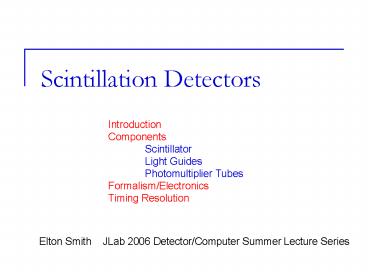Scintillation Detectors - PowerPoint PPT Presentation
1 / 39
Title:
Scintillation Detectors
Description:
Photomultiplier Tubes. Formalism/Electronics. Timing Resolution ... Photomultiplier tube, sensitive light meter. Photocathode. Electrodes. Dynodes. Anode ... – PowerPoint PPT presentation
Number of Views:831
Avg rating:3.0/5.0
Title: Scintillation Detectors
1
Scintillation Detectors
Introduction Components Scintillator Light
Guides Photomultiplier Tubes Formalism/Electronic
s Timing Resolution
- Elton Smith JLab 2006 Detector/Computer Summer
Lecture Series
2
Experiment basics
p 0.3 B R 1.5 GeV/c
B field 5/3 T
L ½ p R 4.71 m
R 3m
3
Measure the Flight Time between two Scintillators
450 ns
Stop
Disc
20 cm
TDC
Start
Disc
300 cm
400 cm
100 cm
4
Measure the Flight Time between two Scintillators
Particle Trajectory
450 ns
Stop
Disc
20 cm
TDC
Start
Disc
300 cm
400 cm
100 cm
5
Propagation velocities
- c 30 cm/ns
- vscint c/n 20 cm/ns
- veff 16 cm/ns
- vpmt 0.6 cm/ns
- vcable 20 cm/ns
- Dt 0.1 ns
- Dx 3 cm
6
TOF scintillators stacked for shipment
7
CLAS detector open for repairs
8
CLAS detector with FC pulled apart
9
Start counter assembly
10
Scintillator types
- Organic
- Liquid
- Economical
- messy
- Solid
- Fast decay time
- long attenuation length
- Emission spectra
- Inorganic
- Anthracene
- Unused standard
- NaI, CsI
- Excellent g resolution
- Slow decay time
- BGO
- High density, compact
11
Photocathode spectral response
12
Scintillator thickness
- Minimizing material vs. signal/background
- CLAS TOF 5 cm thick
- Penetrating particles (e.g. pions) loose 10 MeV
- Start counter 0.3 cm thick
- Penetrating particles loose 0.6 MeV
- Photons, ee- backgrounds 1MeV contribute
substantially to count rate - Thresholds may eliminate these in TOF
13
Light guides
- Goals
- Match (rectangular) scintillator to (circular)
pmt - Optimize light collection for applications
- Types
- Plastic
- Air
- None
- Winston shapes
14
Reflective/Refractive boundaries
Scintillator n 1.58
PMT glass n 1.5
15
Reflective/Refractive boundaries
16
Reflective/Refractive boundaries
17
Reflective/Refractive boundaries
Scintillator n 1.58
PMT glass n 1.5
Acceptance of incident rays at fixed angle
depends on position at the exit face of the
scintillator
18
Winston Cones - geometry
19
Winston Cone - acceptance
20
Photomultiplier tube, sensitive light meter
Gain 106 - 107
Electrodes
Anode
Photocathode
Dynodes
56 AVP pmt
21
Window Transmittance
22
Voltage dividers
- Equal voltage steps
- Maximum gain
- Progressive, higher voltage near anode
- Excellent linearity, limited gain
- Time optimized, higher voltage at cathode
- Good gain, fast response
- Zeners
- Stabilize voltages independent of gain
- Decoupling capacitors
- reservoirs of charge during pulsed operation
23
Voltage Dividers
24
VoltageDivider
25
High voltage
- Positive (cathode at ground)
- low noise, capacitative coupling
- Negative
- Anode at ground (no HV on signal)
- No (high) voltage
- Cockcroft-Walton bases
26
Effect of magnetic field on pmt
27
Housing
28
Compact UNH divider design
29
Electrostatics near cathode at -HV
Stable performance with negative high voltage is
achieved by Eliminating potential gradients in
the vicinity of the photocathode. The
electrostatic shielding and the can of the
crystal are both Maintained at cathode potential
by this arrangement.
30
Dark counts
Solid Sea level Dashed 30 m underground
31
Signal for passing tracks
32
Single photoelectron signal
33
Pulse distortion in cable
34
Electronics
35
Time-walk corrections
36
Formalism Measure time and position
PL
PR
TR
TL
X0
X
X-L/2
XL/2
Mean is independent of x!
37
From single-photoelectron timing to counter
resolution
The uncertainty in determining the passage of a
particle through a scintillator has a statistical
component, depending on the number of
photoelectrons Npe that create the pulse.
Note Parameters for CLAS
38
Average time resolution
CLAS in Hall B
39
Formalism Measure energy loss
PL
PR
TR
TL
X0
X
X-L/2
XL/2
Geometric mean is independent of x!
40
Energy deposited in scintillator
41
Uncertainties
Timing
Assume that one pmt measures a time with
uncertainty dt
Mass Resolution
42
Integral magnetic shield
43
Example Kaon mass resolution by TOF
For a flight path of d 500 cm,
Assume
Note
44
Velocity vs. momentum
p
K
p
45
Summary
- Scintillator counters have a few simple
components - Systems are built out of these counters
- Fast response allows for accurate timing
- The time resolution required for particle
identification is the result of the time response
of individual components scaled by vNpe
46
Magnetic fields































